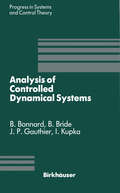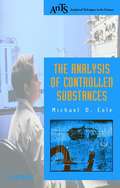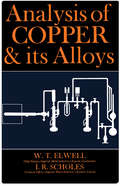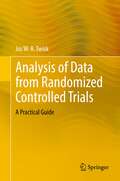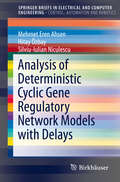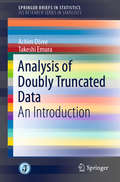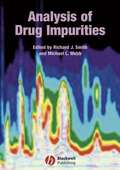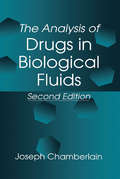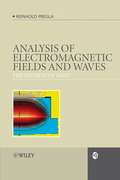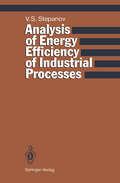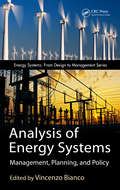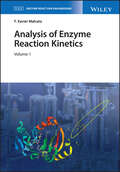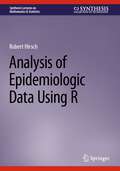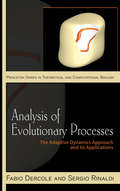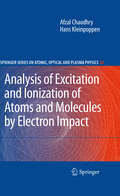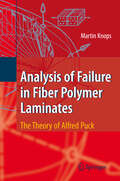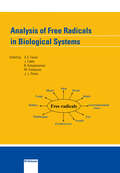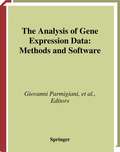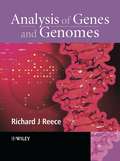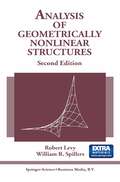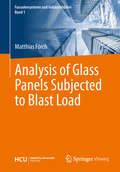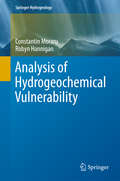- Table View
- List View
Analysis of Controlled Dynamical Systems: Proceedings of a Conference held in Lyon, France, July 1990 (Progress in Systems and Control Theory #8)
by B. Bonnard B. Bride J. P. Gauthier I. KupkaThe conference "Analysis of Controlled Dynamical Systems" was held in July 1990 at the University of LYON FRANCE. About hundred participants attended this conference which lasted four days : There were 50 speakers from departments of Engineering and Mathematics in east and west Europe, USA and USSR. The general subject of the conference was system theory. The main topics were optimal control, structure and control of nonlinear systems, stabilization and observers, differential algebra and systems theory, nonlinear aspects of Hoc theory, rigid and flexible mechanical systems, nonlinear analysis of signals. We are indebted to the scientific committee John BAILLIEUL, Michel FLIESS, Bronislaw JAKUBCZYCK, Hector SUSSMANN, Jan WILLEMS. We gratefully acknowledge the time and thought they gave to this task. We would also like to thank Chris BYRNES for arranging for the publication of these proceedings through the series "Progress in Systems and Control Theory"; BIRKHAUSER. Finally, we are very grateful to the following institutions who through their financial support contributed essentially to the success of this conference : CNRS, Special year " Systemes Dynamiques", DRET, MEN-DAGIC, GRECO-AUTOMATIQUE, Claude Bernard Lyon I University, Entreprise Rhone-Alpes International, Conseil General du RhOne, the cities of LYON and VILLEURBANNE.
The Analysis of Controlled Substances (Analytical Techniques in the Sciences (AnTs) *)
by Michael D. ColePresenting new developments in sampling and drug profiling, this book also provides practical information on how to carry out analysis, what the results mean and how they can be used as court evidence and for drugs intelligence purposes. * Includes case-studies with full data and spectra, helping readers to identify substances * Accessibly organized by class of compound * Contains an up-to-date list of the newest drugs
Analysis of Copper and Its Alloys
by W. T. Elwell I. R. ScholesAnalysis of Copper and Its Alloys provides important information for the satisfactory analysis of typical industrial products. This book presents several instrumental methods for analysis, which involve the use of instruments that are familiar, even in small laboratories. Organized into 34 chapters, this book starts with an overview of the various factors that are common to most methods of sampling copper-base materials, regardless of the quality and quantity of material to be sampled. This text then discusses the safety precautions pertaining to the handling of reagents and apparatus. Other chapters consider the factors that influence the determination when copper is electrolytically deposited in the conventional way, including the simultaneous co-deposition of other metals, the retention of copper, and the inhibiting effect of metals. This book discusses as well the presence of refractory tin oxide in tin-bearing alloys. This book is a valuable resource for chemists, teachers, students, and researchers.
Analysis of Data from Randomized Controlled Trials: A Practical Guide
by Jos W.R. TwiskThis book provides a practical guide to the analysis of data from randomized controlled trials (RCT). It gives an answer to the question of how to estimate the intervention effect in an appropriate way. This problem is examined for different RCT designs, such as RCTs with one follow-up measurement, RCTs with more than one follow-up measurement, cluster RCTs, cross-over trials, stepped wedge trials, and N-of-1 trials. The statistical methods are explained in a non-mathematical way and are illustrated by extensive examples. All datasets used in the book are available for download, so readers can reanalyse the examples to gain a better understanding of the methods used. Although most examples are taken from epidemiological and clinical studies, this book is also highly recommended for researchers working in other fields.
Analysis of Deterministic Cyclic Gene Regulatory Network Models with Delays (SpringerBriefs in Electrical and Computer Engineering)
by Mehmet Eren Ahsen Hitay Özbay Silviu-Iulian NiculescuThis brief examines a deterministic, ODE-based model for gene regulatory networks (GRN) that incorporates nonlinearities and time-delayed feedback. An introductory chapter provides some insights into molecular biology and GRNs. The mathematical tools necessary for studying the GRN model are then reviewed, in particular Hill functions and Schwarzian derivatives. One chapter is devoted to the analysis of GRNs under negative feedback with time delays and a special case of a homogenous GRN is considered. Asymptotic stability analysis of GRNs under positive feedback is then considered in a separate chapter, in which conditions leading to bi-stability are derived. Graduate and advanced undergraduate students and researchers in control engineering, applied mathematics, systems biology and synthetic biology will find this brief to be a clear and concise introduction to the modeling and analysis of GRNs.
Analysis of Doubly Truncated Data: An Introduction (SpringerBriefs in Statistics)
by Takeshi Emura Achim DörreThis book introduces readers to statistical methodologies used to analyze doubly truncated data. The first book exclusively dedicated to the topic, it provides likelihood-based methods, Bayesian methods, non-parametric methods, and linear regression methods. These procedures can be used to effectively analyze continuous data, especially survival data arising in biostatistics and economics. Because truncation is a phenomenon that is often encountered in non-experimental studies, the methods presented here can be applied to many branches of science. The book provides R codes for most of the statistical methods, to help readers analyze their data. Given its scope, the book is ideally suited as a textbook for students of statistics, mathematics, econometrics, and other fields.
Analysis of Drug Impurities (Sheffield Analytical Chemistry Series)
by Richard J. Smith Michael L. WebbA key component of the overall quality of a pharmaceutical is control of impurities, as their presence, even in small amounts, may affect drug safety and efficacy. The identification and quantification of impurities to acceptable standards presents a significant challenge to the analytical chemist. Analytical science is developing rapidly and provides increasing opportunity to identify the structure, and therefore the origin and safety implications of these impurities, and the challenges of their measurement drives the development of modern quantitative methods. Written for both practicing and student analytical chemists, Analysis of Drug Impurities provides a detailed overview of the challenges and the techniques available to permit accurate identification and quantification of drug impurities.
The Analysis of Drugs in Biological Fluids
by Joseph ChamberlainThis new edition focuses on a variety of techniques available for the analysis of drugs in biological fluids. Over 150 figures and tables help to describe the latest advances and give examples of their applications. Current chiral analysis methods as well as discussions on the impact of chirality are described. Practical aspects of bioanalytical work, including many examples of laboratory problems not often reported in the scientific literature, are examined in depth.
The Analysis of Drugs in Biological Fluids
by Joseph ChamberlainThis new edition focuses on a variety of techniques available for the analysis of drugs in biological fluids. Over 150 figures and tables help to describe the latest advances and give examples of their applications. Current chiral analysis methods as well as discussions on the impact of chirality are described. Practical aspects of bioanalytical work, including many examples of laboratory problems not often reported in the scientific literature, are examined in depth.
Analysis of Electromagnetic Fields and Waves: The Method of Lines (RSP #21)
by Reinhold PreglaThe Method of Lines (MOL) is a versatile approach to obtaining numerical solutions to partial differential equations (PDEs) as they appear in dynamic and static problems. This method, popular in science and engineering, essentially reduces PDEs to a set of ordinary differential equations that can be integrated using standard numerical integration methods. Its significant advantage is that the analysis algorithms follow the physical wave propagation and are therefore efficient. This is because the fields on the discretisation lines are described by generalised transmission line (GTL) equations. With this formulation we have a connection to the well known transmission line theory and resulting in an easy understanding. The method of lines is a very accurate and powerful way to analyze electromagnetic waves, enabling a full-wave solution without the computational burden of pure finite element or finite difference methods. With Analysis of Electromagnetic Fields and Waves, Reinhold Pregla describes an important and powerful method for analyzing electromagnetic waves. This book: Describes the general analysis principles for electromagnetic fields. Includes applications in microwave, millimetre wave and optical frequency regions. Unifies the analysis by introducing generalised transmission line (GTL) equations for all orthogonal coordinate systems and with materials of arbitrary anisotropy as a common start point. Demonstrates a unique analysis principle with the numerical stable impedance/admittance transformation and a physical adapted field transformation concept that is also useful for other modelling algorithms. Includes chapters on Eigenmode calculations for various waveguides, concatenations and junctions of arbitrary number of different waveguide sections in complex devices, periodic structures (e.g. Bragg gratings, meander lines, clystron resonators, photonic crystals), antennas (e.g. circular and conformal). Enables the reader to solve partial differential equations in other physical areas by using the described principles. Features an accompanying website with program codes in Matlab© for special problems. Analysis of Electromagnetic Fields and Waves will appeal to electromagnetic field practitioners in primary and applied research as well as postgraduate students in the areas of photonics, micro- and millimetre waves, general electromagnetics, e.g. microwave integrated circuits, antennas, integrated and fibre optics, optoelectronics, nanophotonics, microstructures, artificial materials.
Analysis of Energy Efficiency of Industrial Processes
by Vladimir S. StepanovIt is universally recognized that the end of the current and the beginning of the next century will be characterized by a radical change in the existing trends in the economic development of all countries and a transition to new principles of economic management on the basis of a resource and energy conservation policy. Thus there is an urgent necessity to study methods, technical aids and economic consequences of this change, and particularly, to determine the possible amounts of energy resources which could be conserved (energy "reserves") in different spheres of the national economy. An increased interest towards energy conservation in industry, one of the largest energy consumers, is quite natural and is manifested by the large num ber of publications on this topic. But the majority of publications are devoted to the solution of narrowly defined problems, determination of energy reserves in specific processes and plants, efficiency estimation of individual energy conserva tion measures, etc. However, it is necessary to develop a general methodological approach to the solution of such problems and create a scientific and methodical base for realizing an energy conservation policy. Such an effort is made in this book, which is concerned with methods for studying energy use efficiency in technological processes and estimation of the theoretical and actual energy reserves in a given process, technology, or industrial sector on the basis of their complete energy balances.
Analysis of Energy Systems: Management, Planning and Policy (Energy Systems)
by Vincenzo BiancoThe analysis of energy systems is of paramount importance in modern societies, since it is fundamental to guarantee a sustainable economic development. It combines technical and economic research with a specific focus on quantitative modelling, in order to optimize the modalities of energy demand and supply globally. The book covers major advanced topics related to the analysis of energy by considering different aspects, namely management, planning and policies. The most recent trends, such as smart grids, transition from fossil fuels to renewables based energy systems and distributed generation, are also discussed in this book. Intended to be a collection of various contributions from experts all around the world, it includes latest research results, innovations and methodologies about the analysis of energy systems. The book also focuses to contribute to the current debate related to the evolution of energy systems, by discussing in an open way the pro’s and con’s without any pre-constitute point of view. Title is aimed to be a reference for the academic community, students and professionals with a wider interdisciplinary background. Key Features: Presents integration of renewable sources with conventional energy systems. Topic is addressed from a multidisciplinary point of view, i.e. economy, technical, modelling, planning. Investigates management and planning aspects of future energy supplies. Multidimensional nature of energy systems is highlighted and discussed. Contributes towards implementing policy measures to reduce primary energy consumptions and carbon footprint.
Analysis of Energy Systems: Management, Planning and Policy (Energy Systems)
by Vincenzo BiancoThe analysis of energy systems is of paramount importance in modern societies, since it is fundamental to guarantee a sustainable economic development. It combines technical and economic research with a specific focus on quantitative modelling, in order to optimize the modalities of energy demand and supply globally. The book covers major advanced topics related to the analysis of energy by considering different aspects, namely management, planning and policies. The most recent trends, such as smart grids, transition from fossil fuels to renewables based energy systems and distributed generation, are also discussed in this book. Intended to be a collection of various contributions from experts all around the world, it includes latest research results, innovations and methodologies about the analysis of energy systems. The book also focuses to contribute to the current debate related to the evolution of energy systems, by discussing in an open way the pro’s and con’s without any pre-constitute point of view. Title is aimed to be a reference for the academic community, students and professionals with a wider interdisciplinary background. Key Features: Presents integration of renewable sources with conventional energy systems. Topic is addressed from a multidisciplinary point of view, i.e. economy, technical, modelling, planning. Investigates management and planning aspects of future energy supplies. Multidimensional nature of energy systems is highlighted and discussed. Contributes towards implementing policy measures to reduce primary energy consumptions and carbon footprint.
Analysis of Enzyme Reaction Kinetics (Enzyme Reaction Engineering)
by F. Xavier MalcataComprehensively introduces readers to modelling of rate of enzymatic reactions, including effects of physicochemical parameters Analysis of Enzyme Reaction Kinetics is the second set in a unique eleven-volume collection on Enzyme Reactor Engineering. It describes rate expressions pertaining to enzymatic reactions, including modulation by physicochemical factors, as well as tools for prediction and control of how fast substrates are transformed to products. Volume 1 details rate expressions mathematically derived from mechanistic postulates, and is complemented by appropriate statistical approaches to fit them to experimental data. Volume 2 discusses the effects of physical and chemical parameters upon the rates of both enzyme-catalyzed and enzyme-deactivation reactions. Starting with basic concepts and historical perspectives, the first volume introduces readers to the mathematics of rate expressions. It then goes on to cover kinetic features and the many forms of Michaelis & Menten’s-type rate expressions (single and multiple enzymes, autocatalysis, single and multiple substrates, multiphasic systems, etc.), and concludes with the statistical analysis of rate expressions – including the assessment of data, fitting of models to data, and generation of data themselves. The second volume introduces readers to physicochemical modulation of reaction rate – starting with basic concepts, and looking specifically at temperature-, mechanical force-, pH- and compound-driven effects: both unimodal and bimodal deactivation are considered. Analysis of Enzyme Reaction Kinetics 2V Set is a comprehensive work for those studying or working with enzyme reactions, or practitioners involved in the control of reactors. SERIES INFORMATION Enzyme Reactor Engineering is organized into four major sets: Enzyme Reaction Kinetics and Reactor Performance; Analysis of Enzyme Reaction Kinetics; Analysis of Enzyme Reactor Performance; and Mathematics for Enzyme Reaction Kinetics and Reaction Performance.
Analysis of Enzyme Reaction Kinetics (Enzyme Reaction Engineering)
by F. Xavier MalcataComprehensively introduces readers to modelling of rate of enzymatic reactions, including effects of physicochemical parameters Analysis of Enzyme Reaction Kinetics is the second set in a unique eleven-volume collection on Enzyme Reactor Engineering. It describes rate expressions pertaining to enzymatic reactions, including modulation by physicochemical factors, as well as tools for prediction and control of how fast substrates are transformed to products. Volume 1 details rate expressions mathematically derived from mechanistic postulates, and is complemented by appropriate statistical approaches to fit them to experimental data. Volume 2 discusses the effects of physical and chemical parameters upon the rates of both enzyme-catalyzed and enzyme-deactivation reactions. Starting with basic concepts and historical perspectives, the first volume introduces readers to the mathematics of rate expressions. It then goes on to cover kinetic features and the many forms of Michaelis & Menten’s-type rate expressions (single and multiple enzymes, autocatalysis, single and multiple substrates, multiphasic systems, etc.), and concludes with the statistical analysis of rate expressions – including the assessment of data, fitting of models to data, and generation of data themselves. The second volume introduces readers to physicochemical modulation of reaction rate – starting with basic concepts, and looking specifically at temperature-, mechanical force-, pH- and compound-driven effects: both unimodal and bimodal deactivation are considered. Analysis of Enzyme Reaction Kinetics 2V Set is a comprehensive work for those studying or working with enzyme reactions, or practitioners involved in the control of reactors. SERIES INFORMATION Enzyme Reactor Engineering is organized into four major sets: Enzyme Reaction Kinetics and Reactor Performance; Analysis of Enzyme Reaction Kinetics; Analysis of Enzyme Reactor Performance; and Mathematics for Enzyme Reaction Kinetics and Reaction Performance.
Analysis of Epidemiologic Data Using R (Synthesis Lectures on Mathematics & Statistics)
by Robert HirschThis book addresses the description and analysis of occurrence data frequently encountered in epidemiological studies. With the occurrence of Covid-19, people have been exposed to the analysis and interpretation of epidemiological data. To be informed consumers of this information, people need to understand the nature and analysis of these data. Effort is made to emphasize concepts rather than mathematics. Subjects range from description of the frequencies of disease to the analysis of associations between the occurrence of disease and exposure. Those analyses begin with simple associations and work up to complex relationships that involve the control of extraneous characteristics. Analyses rely on the statistical software R, which is freeware in wide use by professional epidemiologists and other scientists.
Analysis of Evolutionary Processes: The Adaptive Dynamics Approach and Its Applications (PDF)
by Fabio Dercole Sergio RinaldiQuantitative approaches to evolutionary biology traditionally consider evolutionary change in isolation from an important pressure in natural selection: the demography of coevolving populations. In Analysis of Evolutionary Processes, Fabio Dercole and Sergio Rinaldi have written the first comprehensive book on Adaptive Dynamics (AD), a quantitative modeling approach that explicitly links evolutionary changes to demographic ones. The book shows how the so-called AD canonical equation can answer questions of paramount interest in biology, engineering, and the social sciences, especially economics. After introducing the basics of evolutionary processes and classifying available modeling approaches, Dercole and Rinaldi give a detailed presentation of the derivation of the AD canonical equation, an ordinary differential equation that focuses on evolutionary processes driven by rare and small innovations. The authors then look at important features of evolutionary dynamics as viewed through the lens of AD. They present their discovery of the first chaotic evolutionary attractor, which calls into question the common view that coevolution produces exquisitely harmonious adaptations between species. And, opening up potential new lines of research by providing the first application of AD to economics, they show how AD can explain the emergence of technological variety. Analysis of Evolutionary Processes will interest anyone looking for a self-contained treatment of AD for self-study or teaching, including graduate students and researchers in mathematical and theoretical biology, applied mathematics, and theoretical economics.
Analysis of Excitation and Ionization of Atoms and Molecules by Electron Impact (Springer Series on Atomic, Optical, and Plasma Physics #60)
by Afzal Chaudhry Hans KleinpoppenThe content of this book describes in detail the results of the present measurements of the partial and total doubly differential cross sections for the multiple-ionization of rare gas atoms by electron impact. These measurements show, beside other trends, the role of Auger transitions in the production of multiply ionized atoms in the region where the incident electron energy is sufficient to produce inner shell ionization. Other processes like Coster-Kronig transitions and shake off also contribute towards increasing the charge of the ions. The incident electron having energy of 6 keV, for example, in a collision with xenon atom can remove up to nine electrons! (*) X-ray-ion coincidence spectroscopy of the electron xenon atom collisions is also described. The present measurements of doubly differential cross sections for the dissociative and non-dissociative ionization of hydrogen, sulfur dioxide and sulfur hexa fluoride molecular gases by electron impact are also described in the text of this book. The results of the measurements for sulfur dioxide molecule show how this major atmospheric pollutant can be removed from the atmosphere by electron impact dissociation of this molecule. The present results of the measurements for sulfur hexa fluoride give an insight into the dissociation properties of this molecular gas, which is being so widely used as a gaseous insulator in the electrical circuits. The book also describes the present measurements of the polarization parameters of the fluorescence radiation emitted by the electron-impact-excited atoms of sodium and potassium. In these investigations the target atoms are polarized, therefore, the measurements of the polarization parameters give information about the electron atom interaction in terms of the interference, direct and exchange interaction channels.
Analysis of Failure in Fiber Polymer Laminates: The Theory of Alfred Puck
by Martin KnopsWritten by Puck's pupil and appointed successor Martin Knops, this book presents Alfred Puck´s failure model, which, among several other theories, predicts fracture limits best and describes the failure phenomena in FRP most realistically – as confirmed within the "World-wide Failure Exercise". Using Puck´s model the composite engineer can follow the gradual failure process in a laminate and deduce from the results of the analysis how to improve the laminate design.
Analysis of Free Radicals in Biological Systems
by J. L. Pierre A. Favier J. Cadet B. Kalyanaraman M. Fontecave"Oxidative stress" is used as the generic term describing the involve ment of reactive oxygen species in various human diseases. The scope of such a topic is becoming increasingly wide. The recent interest in radicals such as nitric oxide and the discovery of new mechanisms such as the effect of free radicals on redox sensitive proteins and genes are enlarging our understanding of the physiological role of free radicals. Oxidative stress is involved in numerous pathological. processes such as ageing, respiratory or cardiovascular diseases, cancer, neurological pathologies such as dementia or Parkinson's disease. It still remains difficult, however, to demonstrate by chemical measurement the in vivo production of free radicals and even more to realise their speciation. Therefore, the development of new tools and indicators is engrossing many researchers working in this field. Reliable indicators are abso lutely necessary not only to monitor the evolution of oxidative stress in patients but also to evaluate the efficiency of new antioxidant treat ments. The French Free radical club of Grenoble, the CERLIB has been involved for many years in the organisation of international training programs on methodology, in order to provide both theoretical and practical help to researchers from various countries. Such training sessions have been highly successful and participants value the oppor tunity to learn reliable techniques. This positive echo explains why the researchers of CERLIB decided, with the help of Prof. Dr. B. Kalyanaraman, to publish selected techniques on free radical re search.
The Analysis of Gene Expression Data: Methods and Software (Statistics for Biology and Health)
by Giovanni Parmigiani Elizabeth S. Garett Rafael A. Irizarry Scott L. ZegerThis book presents practical approaches for the analysis of data from gene expression micro-arrays. It describes the conceptual and methodological underpinning for a statistical tool and its implementation in software. The book includes coverage of various packages that are part of the Bioconductor project and several related R tools. The materials presented cover a range of software tools designed for varied audiences.
Analysis of Genes and Genomes
by Richard J. ReeceThis beautifully illustrated textbook provides a clear guide to the tools and techniques of genetic engineering, gene cloning and molecular biology. All aspects of genetic engineering in the post-genomic era are covered, beginning with the basics of DNA structure and DNA metabolism. Using an example-driven approach, the fundamentals of creating mutations in DNA, cloning in bacteria, yeast, plants and animals are all clearly presented. Strong emphasis is placed on the latest, post genomic technologies including DNA macro and microarrays, genome-wide two hybrid analysis, proteomics and bioinformatics. A modern post-genome era introduction to key techniques used in genetic engineering. An example driven past-to-present approach to allow the experiments of today to be placed in an historical context The book is beautifully illustrated in full-colour throughout. Associated website including updates, additional content and illusions
Analysis of Geometrically Nonlinear Structures
by Robert Levy William R. SpillersThe availability of computers has, in real terms, moved forward the practice of structural engineering. Where it was once enough to have any analysis given a complex configuration, the profession today is much more demanding. How engineers should be more demanding is the subject of this book. In terms of the theory of structures, the importance of geometric nonlinearities is explained by the theorem which states that "In the presence of prestress, geometric nonlinearities are of the same order of magnitude as linear elastic effects in structures. " This theorem implies that in most cases (in all cases of incremental analysis) geometric nonlinearities should be considered. And it is well known that problems of buckling, cable nets, fabric structures, ... REQUIRE the inclusion of geometric nonlinearities. What is offered in the book which follows is a unified approach (for both discrete and continuous systems) to geometric nonlinearities which incidentally does not require a discussion of large strain. What makes this all work is perturbation theory. Let the equations of equilibrium for a system be written as where P represents the applied loads, F represents the member forces or stresses, and N represents the operator which describes system equilibrium.
Analysis of Glass Panels Subjected to Blast Load (Fassadensysteme und Gebäudehüllen #1)
by Matthias FörchThe present doctoral dissertation contributes to the analysis of glass panels subjected to blast load, concentrating on monolithic and laminated glass prior to glass fracture. A straightforward graphical solution for monolithic glass is presented to identify maximum deformation and maximum principal stress for small and large deformations for static and idealized blast load without software. On the basis of experimental tests, load duration factors kmod for impact and blast load design for annealed glass, heat strengthened glass and fully tempered glass are proposed. In addition, design strength values for impact and blast design based on the European and German standards are suggested. As a result, blast pressure capacity charts for monolithic fully tempered glass plates subjected to idealized blast load are presented. Moreover, design temperatures of interlayer in blast design situation based on empirical data in accordance with Eurocode are determined for vertical double glazed and triple glazed units for Germany, showing that laminated glass should not be regarded with monolithic glass approach in general.
Analysis of Hydrogeochemical Vulnerability (Springer Hydrogeology)
by Constantin Moraru Robyn HanniganThis monograph instructs the reader on how to analyze the hydrogeochemical vulnerability. It introduces notions of geochemical signals, points of migration of pollutants in the unsaturated zone, and new hydrogeochemical classifications. Three test sites in the USA, Germany, and Moldova are described as case studies accompanied by illustrative data. The authors presuppose for future readers only the background mathematics and elementary knowledge of hydrogeology. The presented methodology is both for local and regional assessments. It is simple, does not need implication of high qualification specialists and can be applied to test the groundwater quality. The book is useful for undergraduate, graduate, master, and PhD students as well as water quality specialists, ecologists and geology professionals.
